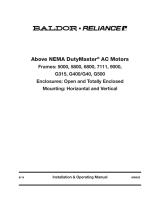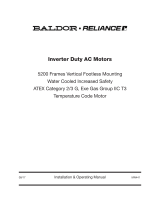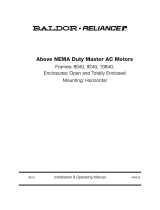Page is loading ...

1
INSTALLATION:
STEP 1: PRE-ASSEMBLY INSPECTION
All parts should be examined for any damage during the shipping
and handling process. Measurement should be taken to ensure
parts meet application requirements, such as hub and shaft ts,
shaft separation, etc. All parts must be clean and free of any
foreign material before attempting assembly.
STEP 2: INSTALLATION OF KEYS
Install keys in respective shafts. Keys should t keyseat with a
tight t on the sides and slight clearance over the key. Use plastic
oil sealing compound around keys to prevent loss of lubricant.
STEP 3: MOUNTING HUBS
Set cover halves with seals on the shaft prior to mounting shaft
hubs. Remove lube plugs from each cover half and insert the
seals into the cover half. Place cover halves as far back on
respective shafts with anges facing each other. Place gasket on
shaft and move as far back on shaft as possible.
Shrink Fit: Straight bore hubs require the hub be expanded
prior to mounting. Degrease all contact surfaces insure all plugs
are removed. Heat the hub in an oil bath or oven until bore is
larger than shaft diameter (approx. 250°C (482°F) in an ambient
temperature of 20°C (68°F)). Use extreme caution if heating bore
with an open ame: To avoid distortion, it is essential that hub be
heated evenly. When placing the hub onto the shaft, ensure that
the seal is protected from the heat of the hub. Once the hub is
cooled secure seals.
NOTE: Interference fit limitation for keyed hub is a maximum
of .00075” interference pre inch of shaft diameter.
STEP 4: ALIGNMENT
ANGULAR ALIGNMENT
NOTE: Proper alignment yields the longest service life.
WARNING: Because of the possible danger to person(s) or
property from accidents which may result from the improper
use of products, it is important that correct procedures be
followed: Products must be used in accordance with the
engineering information specified in the catalog. Proper
installation, maintenance and operation procedures must
be observed. The instructions in the instruction manuals
must be followed. Inspections should be made as necessary
to assure safe operation under prevailing conditions. Proper
guards and other suitable safety devices or procedures as
may be desirable or as may be specified in safety codes
should be provided, and are neither provided by Baldor
Electric Company nor are the responsibility of Baldor
Electric Company. This unit and its associated equipment
must be installed, adjusted and maintained by qualified
personnel who are familiar with the construction and
operation of all equipment in the system and the potential
hazards involved. When risk to persons or property may be
involved, a holding device must be an integral part of the
driven equipment beyond the speed reducer output shaft.
Instruction and Lubrication Manual for S-Series Grid Couplings
These instructions must be read thoroughly before installing or operating this product.
A. Instrument Method of checking alignment is recommended
since it is most accurate. Rigidly attach dial base to one of
the hubs and indicator needle against a face of the other
hub. Rotate both hubs 360°. Take indicator reading at four
points, 90° apart. Adjust alignment until all four readings are
within angular misalignment limits given in Table 1. To check
alignment, relocate the dial base to the opposite hub and
repeat the procedure.
B. Caliper / Feeler Gauge Method may be used if dial
indicator is not available or shaft gap is too small; however,
it is not the recommended method of checking alignment.
Check with calipers or feeler gauge at four points, 90° apart.
Adjust alignment until all four readings are within angular
misalignment limits as shown in Table 1.
PARALLEL ALIGNMENT
A. Instrument Method is again recommended since it is
most accurate. Rigidly attach dial base to one hub and set
dial indicator button in contact with an outside diameter
of opposite hub. Rotate both hubs 360°. Take indicator
reading at four points 90° apart. Adjust alignment until all
four readings are within parallel misalignment limits given in
Table 1. To check alignment, relocate dial base on opposite
hub and repeat the procedure. Recheck angular alignment.
B. A Straight Edge and Feeler Gauge may be used if a dial
indicator is not available; however, it is not recommended
as the most accurate method of checking alignment. Adjust
alignment until straight edge appears to be resting squarely
on both outside tooth diameters. Repeat procedure at
3 additional points,90°apart. Refer to Table 1 for limits of
parallel misalignment. Recheck angular alignment.
Table 1 - Alignment Limits
Size 150 220 - 380 480
Parallel Misalignment
(mm)
0.51 0.51 0.51
Angular Misalignment
(mm)
0.51 0.51 0.51
Gap (mm) 2-6 2-7 3-8
STEP 5: POSITIONING OF THE GRIDS
Couplings up to size 480 will include two identical spring
grids which will sit on top of one another within the teeth. It
is recommended that a staggered arrangement be used when
positioning the spring grid segments. Refer to table 2 for the
total number of grid segments.
Table 2 - Total Number of Grid Segments
Size 150 220 300 380 480
Number of Grid Segments 10 12 14 16 14
Table 3 - Weight of Grease
Running Limit Temperature T° = -20°C - +110°C (-4°F - +230°F)
Grease Weight Per Coupling
Size 150 220 300 380 480
Kg 12 22 27 30 45
Lbs. 26.46 48.50 59.52 66.14 99.21

P.O. Box 2400, Fort Smith, AR 72902-2400 U.S.A., Ph: (1) 479.646.4711, Fax (1) 479.648.5792, International Fax (1) 479.648.5895
Dodge Product Support
6040 Ponders Court, Greenville, SC 29615-4617 U.S.A., Ph: (1) 864.297.4800, Fax: (1) 864.281.2433
www.baldor.com
© Baldor Electric Company
MN4058
All Rights Reserved. Printed in USA.
02/14 Printshop 200
*4058-0214*
STEP 6: ASSEMBLING
Before inserting the grids, hand pack hub teeth with lubricant.
(Refer to Tables 3 and 4 for recommendations on type and
quantity of lubricant.) Fit grid over hubs and starting at one end
work coils of grid between the teeth. Seat with a soft mallet. Be
sure to use a staggered pattern when installing multiple layers
of the grids. Hand pack more lubricant around the grid and
between the spaces of the grid after it is installed.
Bring together the vertical cover halves and align all bolt holes.
Lube holes should be 180° apart. All bolts are grade 8.8 in
accordance with ISO. All sizes use hex head cap screws. On
Sizes 150 to 480, one half of the covers is secured on the driving
hub by screws and spring dowels. Tighten bolts to tightening
torque given in Table 5.
STEP 7: LUBRICATION
Remove both lube plugs in cover and insert lube tting. Pump in
appropriate lubricant and amount of lubricant (per Tables 3 and
4) until it is forced out of the opposite lube hole, then install lube
plugs in holes.
NOTE: All lube plugs must be installed before operating
coupling.
NOTE: Proper lubrication of all types of GRID-LIGN
couplings is necessary for their efficient operation and long
service life.
Table 4 lists lubricants from several manufacturers, which will
perform satisfactorily under average industrial conditions as long
as the ambient temperature is within the limits of 0°F to 150°F
(–18°C to +66°C). This table does not constitute a complete listing
of acceptable lubricants, and is not meant to prohibit the use
of lubricants with equivalent properties. Lubricants required for
severe operating conditions should be referred to CO Engineering
(864-284-5700) or a lubrication manufacturer’s representative
for recommendations. Under average industrial conditions it is
recommended that GRID-LIGN coupling lubricants meet the
specications listed in Table 2.
Table 4 -- Suggested Lubricants
(Ambient Temperature 0°F to 150°F)
Manufacturer Name of Lubricant
Amoco Amolith #2
Citgo Citgo HEP-2
Conoco EP Conolith #2
Exxon Ronex MP
Mobil Moilux EP-1 and EP-2
Shell Alvania Grease #2
Sun Oil Prestige 42
S-Series Grid Lubricant Recommendations:
• Ambient Temperature Range: 0°F to 150°F (–18°C to+66°C)
• NLGI Rating: 1 through 3 per ASTM D-217
• Minimum Base Oil Viscosity: 750 SSU @ 100°F per ASTM
D-445
• Minimum Dropping Point: 220°F (105°C) per ASTM D-556
or D-2265
• Maximum Thickener Content: 8% Oxidation Resistance,
• Maximum Pressure Drop: 20 psi@ 100 hours per ASTM
D-942
• Recommended Properties: anti-oxidation, anti-rust, extreme
pressure.
Step 8: Maintenance
Maintenance is recommended every 6 months to ensure long life.
Disassemble coupling, remove old lubricant and clean. Visually
inspect all parts. Replace any worn parts. Hand pack coupling
with lubricant and repeat Step 6.
Step 9: Grid Removal
When it is necessary to disassemble coupling, remove cover
halves. Beginning at a cut end of grid, carefully insert a
screwdriver into loop. Using the teeth for lever-age, gradually pry
the grid up, alternating sides while working around the coupling.
Table 5 - Bolt Torque Values
Size
Half Cover Fixing Bolts Cover Flange Bolts
Quantity Size x Length
Bolt Torque
(Ft-Lbs)
Bolt Torque
(N-m)
Quantity Size x Length
Bolt Torque
(Ft-Lbs)
Bolt Torque
(N-m)
150 6 M20 x 70mm 310 420 6 M18 x 60mm 300 406
220 6 M20 x 70mm 310 420 8 M18 x 60mm 300 406
300 10 M20 x 70mm 310 420 16 M20 x 60mm 310 420
380 12 M20 x 70mm 310 420 18 M20 x 60mm 310 420
480 12 M20 x 70mm 310 420 18 M20 x 60mm 310 420
/




